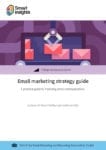When hyper-personalized emails miss the mark, they aren’t just ineffective — they’re downright unsettling.
To assess the effectiveness of personalization, my company conducted a real-world experiment. We paid a couple thousand dollars for a couple hundred hyper-personalized emails and then measured their successes against a similar number of generic and relevant emails. As it turned out, those run-of-the-mill emails performed better than the personalized ones by a substantial margin.
Why is that? Well, the truth is that most marketers believe that they know who their target audience is, so they integrate that knowledge into an approach that uses personalized emails that they feel is most effective.
When these hyper-personalized emails miss the mark, they aren’t just ineffective, they’re downright unsettling. According to a RichRelevance study, despite mostly enjoying personalized experiences from brands, up to 75% of US consumers deemed most forms of personalized business communications “at least somewhat creepy.”

If consumers feel that a brand’s email marketing efforts invade their personal space, they’ll attach similar sentiments to all of that company’s messaging. For marketers, this poses a unique challenge. How do they create emails and messages that resonate with their audiences without feeling invasive?
Being relevant without crossing a line
No matter what channel it appears on, brand messaging must strike a balance between particular and personal. It’s OK to tailor a message toward an individual, but don’t do it to the extent that it’s off-putting to the intended target.

Let’s say, for example, that you’re sending a follow-up email to a lead or valued customer. It’s fine to pepper the message with details such as a personal greeting or how long they’ve been a customer. Just don’t get too familiar and include facts such as how long they’ve worked with their current employer.
Instead, focus on the pain points your recipient’s industry is facing. Use any data you might have about your target audience to learn what those struggles are. If that’s not an adequate starting place, then check out industry-specific blogs, publications, or message boards.
These publications and forums can help you get a sense of an industry’s current talking points. You should be able to glean enough information from these pieces to search through social platforms for relevant conversations as well as popular industry conferences. From there, use that information to create emails that directly address those pain points in a not-so-invasive manner.
Consider this example: Let’s say you’re an IT company that wants to get in contact with people who manage IT departments for small to midsize businesses. Putting details in your emails such as where each prospect went to college will not work. Offering solutions to the most common problems for these IT managers and directors will.
Using data to craft your messages
The data you collect from your search and social efforts will be critical to gaining the insight you need in order to craft emails with a personal touch. Once you have that data, these steps will help you put it to its best use:
1. Connect all your data sources
Data and AI are at the heart of personalization, so much so that consumers expect some degree of customized experiences in all their product interactions. However, a lot of marketing departments run on three or four data silos, and that disconnect is a big reason why hyper-personalized emails often seem off.

The first step, then, is to break down those silos and allow data from search engine optimization, social media marketing, and email leads to flow together. Consumers spread their voices, interests, and concerns across all mediums, and AI systems can find relevant threads only if they’re searching through all the relevant data.
Phasing out those silos could mean signing up for a platform that can bring your data together or tasking your tech team to integrate each channel. Whatever path you take, the result will be a truly fleshed-out look at the information needed to write emails that really connect with readers.
2. Don’t be afraid to fail
Using SEO and social media data to transform email marketing can seem like a novel idea, so your team’s first few attempts might not yield the results you expect. Use those failed attempts to inform any next steps you take.
Track every aspect of an email campaign, from the subject lines to the calls to action and everything between. Take note of what works and what doesn’t. If you monitor all of it, every failure becomes useful data to add to the pool.
Download our Individual Member Resource – Email marketing strategy guide
This comprehensive guide shows you how to take your email marketing strategy to the next level, covering a lot more than tips to improve your creative and copy.
Access the Email marketing strategy guide
That also means being able to adjust to new data on the fly. If a subject line doesn’t work, change it. If it does, track its success and change it when the returns begin to diminish. Spotify and Pandora are driven by algorithms that customize users’ playlists in real-time according to what songs they like, dislike, and skip; use the success and failure that your data reveals in order to make similar adjustments to your email strategy.
3. Let audience feedback guide you
While emails don’t have like, dislike, and skip buttons, they can still paint a clear picture of audience opinion. If something offends your audience or is seen as uncomfortably personal, they’ll let you know; if not, the data will let you know when your emails stop getting the desired responses.
Take that feedback seriously and make data analytics an integral part of your marketing team. That can even go beyond email: Phrases or other elements that don’t work in your email messaging probably won’t work in ads or on-site content, either.
If your company doesn’t have a dedicated in-house analytics team, consider outsourcing to data scientists. My company worked with one, and it helped us join some of those siloed entities and get more granular with our email marketing data without adding another full-time hire.
Littering a stranger’s email with personal information isn’t exactly endearing. Instead, use all of the data at your disposal to find out what industry- and role-specific concerns they have. Show you know who they are by solving their pain points, and you’ll truly have personalization down to a science.
Jeff Winters, founder and CEO of
Sapper Consulting, understands that lead generation is crucial for businesses. He collaborates with clients to customize strategies that generate high-quality sales opportunities.










